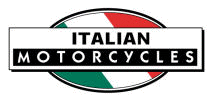


The single-cylinder Borgo, showing the extended ribbed exhaust port which takes the place of the silencer. The engine dimensions are 85 mm. x 88 mm. = 499 c.c.

The tandem-seated Borgo, a new Italian production. A variable pulley gear In conjunction with an extensible rear frame is adopted.
An Interesting Italian Machine Reminiscent of Several British Makes.
WE have on more than one occasion commented favourably on the clean lines and attractive appearance of the motor cycles lately produced in Italy, and noted a growing resemblance to British motor cycle design. The Borgo machine, which we illustrate herewith, is no exception to the general tendency referred to; it is taking in design and of sound construction.
The engine, which strongly resembles the Rudge, has a bore and stroke of 85 x 88 mm. (499 c.c.), the popular British size; the inlet valve is overhead, and, of course, mechanically operated ; the Bosch magneto is carried in front on a platform cast with the crank case, is handle-bar controlled, and provided with a cut-out. Reference to the illustration of the single-seated model will show that the timing gear and magneto transmission are contained beneath a single cover - a very commendable practice - but the cover itself strikes us as being rather ornate, for though the coat-of-arms looks well when clean, it will, in use, collect much dirt, which will be difficult to remove. The outside of a crank case should be smooth and free from crevices. The carburetter - a special two-lever type - is constructed in the Borgo factory. The silencer, it will be noticed, is unusual in appearance, and although it will probably prove very effective from the point of view of absence of back pressure, it is unlikely that its silence would satisfy the authorities in this country unless it were furnished with a pipe to the rear. Both oil and petrol pipes are provided with rubber insertions. So much for the power unit.
The Variable Gear.
Turning now to other details, we come to what is perhaps the most novel point of the whole machine, viz., the variable gear. This consists of an expanding pulley such as is fitted to several British machines, and a method of maintaining correct belt tension by moving the rear wheel in the manner of the Zenith. However, in this case, not the rear wheel only, but the whole of the rear part of the frame moves backwards and forwards. This rear portion is pivoted below the saddle, and the front ends of the chain stays are carried by the extremities of a long lever, which extends upwards on the left side of the tank and has its fulcrum on the engine bracket. When this lever is pushed forward it forces the wheel backwards and tightens the belt, at the same time opening the pulley. The pulley can be further controlled by rotating the lever ; thus, a free engine and clutch can be brought into use at. the requirements of the rider. The pedalling gear (used for starting purposes only) is mounted upon the chain stays, and so the tension of the chain is unaffected by any" movement of the wheel ; the chain is, however, provided with a jockey pulley on its under side. The arrangement of the movable part of the frame and the distribution of weight is such that the weight of the rider tends to maintain the belt tension.
Tandem Seats.
The cantilever arrangement upon which the saddle is mounted is reminiscent of another British machine, viz., the Rex. In one of the illustrations a second seat, together with hand grips and footrests, is shown mounted in the rear. This method of carrying a passenger is very popular in Italy, being much cheaper than a side-car and more comfortable than the padded pillion seat. The handle-bars are adjustable, on the lines of the A. B.C. or Indian, but the spring forks are essentially Italian. Two brakes are applied to the belt rim - one on either side of the V - and both are operated from the handle-bars by means of Bowden cables. The stand is of the spring-up variety, bat differs from those to which we are accustomed in this country. When a carrier is fitted, neatly constructed metal-cased tool boxes are supplied. The tyres are heavy Dunlops, 26in. X 2&frace34;in.
We understand that the Borgo (but with a single gear) is being supplied in large quantities to the Italian Government. The Italian manufacturers are making but few changes for 1916, as the more important houses are fully occupied with Government work, while business in general is more or less at a standstill. Messrs. Bianchi, whose motor cycle we illustrated and described some time ago, are adopting belts instead of chain drive, for the sake, we presume, of economy and simplicity.
The Motor Cycle, November 11th, 1915. Page 461.
If you have a query or information about Moto Borgo please contact us